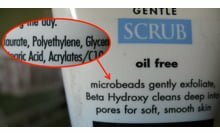 Microplastics — likely from facial scrubs and other personal care products — are polluting the Great Lakes, according to scientific research published by the 5 Gyres Institute.
Microplastics — likely from facial scrubs and other personal care products — are polluting the Great Lakes, according to scientific research published by the 5 Gyres Institute.
The nonprofit say this is the same evidence it presented to Procter & Gamble, Johnson & Johnson, L’Oreal, The Body Shop, Colgate-Palmolive and Unilever, prompting the brands to phase out the use of these tiny plastic beads.
The 5 Gyres Institute published the first microplastic pollution survey of the Great Lakes region, in collaboration with researchers from the State University of New York (SUNY) in Fredonia, in Marine Pollution Bulletin, a peer-reviewed journal. The researchers found high concentrations of microplastics in the Great Lakes, more than most ocean samples collected worldwide by 5 Gyres, says its co-founder Dr. Marcus Eriksen, lead author of the research paper. The nonprofit says it is the first research organization to have studied and documented plastic pollution in all of Earth's five oceans.
The Great Lakes micro-plastics discovered “were of similar size, shape, texture and composition to plastic micro-beads found in many consumer products used as exfoliants, giving us evidence that these products, designed to be washed down the drain, are not adequately being captured by sewage treatment,” Eriksen says.
The particles can be easily mistaken for food by fish in the lakes and ingested and, in turn, may be ingested by humans, 5 Gyres says. According to Eriksen there is no practical way to remove the plastic from the lakes. The material’s lifespan is unknown.
The organization says it is working with advisors to produce model legislation that states and municipalities can use to ban micro-plastics as ingredients in consumer products because of their tendency to escape sewage treatment.
The highest plastic abundance that 5 Gyres and SUNY Fredonia researches measured in the Great Lakes was 466,000 particles/km2 with an average of 43,000 particles/km2 throughout all the samples. The highest concentrations of micro-plastics were observed in Lake Erie, and accounted for about 90 percent of the total plastics found. In addition to polyethylene and polypropylene beads found in the samples, there were also particles of aluminum silicate, or coal ash, a byproduct of coal fired power plants.
In partnership with the Plastic Soup Foundation and Stichting De Noordzee of the Netherlands, 5 Gyres has launched the microsite BeatTheMicroBead.org and an international mobile app, which allows consumers to scan the barcode of personal care products to determine whether they contain plastic micro-beads and whether the manufacturer has agreed to remove them.
Image Credit: 5 Gyres Institute